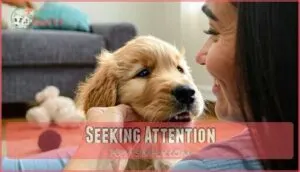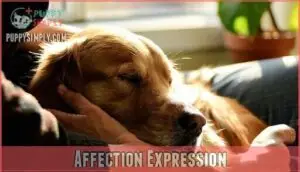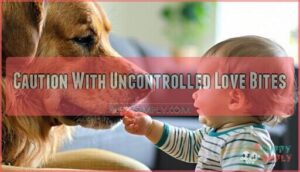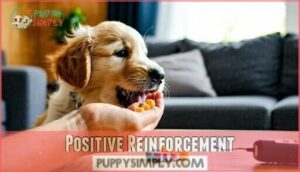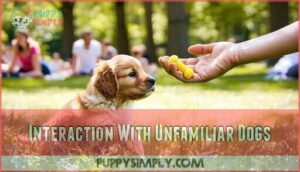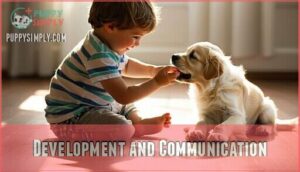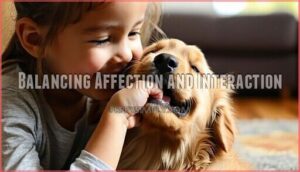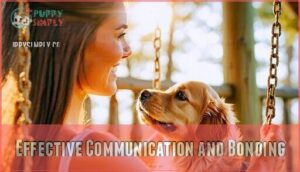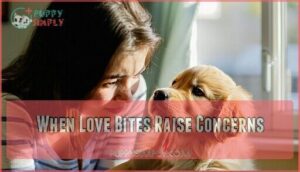This site is supported by our readers. We may earn a commission, at no cost to you, if you purchase through links.
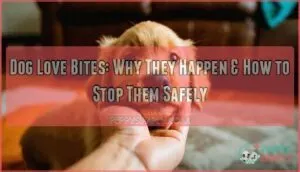
These soft mouthings aren’t aggressive—they’re actually leftover puppy behaviors from littermate play.
Your dog might nibble when they want your focus, smell something interesting on your skin, or simply feel playful.
While adorable, uncontrolled love bites can escalate or frighten visitors.
You can redirect this behavior using positive reinforcement and offering appropriate chew toys when nibbling starts.
Understanding why your furry friend does this helps strengthen your bond while teaching proper boundaries that keep everyone comfortable and happy.
Table Of Contents
- Key Takeaways
- Understanding Dog Love Bites
- Reasons Behind Nibbling
- Caution With Uncontrolled Love Bites
- Managing Love Bites
- Development and Communication
- Balancing Affection and Interaction
- Effective Communication and Bonding
- When Love Bites Raise Concerns
- Ensuring Healthy Dog-Human Relationship
- Frequently Asked Questions (FAQs)
- What does it mean when your dog gently bites you?
- What does it mean when dogs give you love bites?
- Why does my dog nibble me gently?
- Can puppies give love bites too early?
- Do love bites hurt senior dogs more?
- Should I love bite my dog back?
- Are love bites contagious between dogs?
- Do love bites indicate dental problems?
- Conclusion
Key Takeaways
- Your dog’s gentle nibbles are signs of affection – They’re using their mouth to communicate love and bond with you, similar to how they’d groom pack members in the wild.
- You need to set boundaries early – Without proper bite inhibition training, even loving nibbles can escalate and potentially injure children or make guests uncomfortable.
- Redirect the behavior with positive reinforcement – When your dog starts nibbling, offer them appropriate chew toys and reward them when they stop, rather than punishing the behavior.
- Watch for warning signs that indicate problems – If you notice increased pressure, aggressive body language, or actual injuries occurring, you’ll need immediate intervention to prevent the behavior from becoming dangerous.
Understanding Dog Love Bites
Dog love bites are gentle nibbles your furry friend uses for dog communication and affection expression.
Unlike aggressive biting, these playful bites involve minimal pressure when dog teeth touch your skin during mouthing affection.
Puppies naturally engage in puppy mouthing to explore their world, while adult dogs use play biting to seek attention or show fondness.
Understanding bite inhibition helps you recognize when your dog’s gentle nibbling is simply their way of saying "I love you" through this unique form of canine interaction.
Some dogs may also exhibit this behavior if they crave attention from their owners, which can be a sign of their need for affection.
Reasons Behind Nibbling
Your dog’s nibbling behavior stems from several natural instincts and needs that drive this gentle form of communication.
Understanding your dog’s gentle nibbles reveals their natural way of saying "I care about you.
Understanding these motivations helps you respond appropriately and strengthen your bond with your furry companion.
Seeking Attention
Sometimes attention-seeking behavior drives dog love bites more than we realize.
Your pup might nibble when they’re craving interaction, especially if ignoring attention hasn’t worked before.
Dogs can’t exactly tap you on the shoulder, so mouthing affection becomes their go-to communication method.
Different breed tendencies affect this behavior—some dogs have lower attention thresholds than others.
When play biting starts, try alternative actions like offering a toy or stepping away briefly.
Vocal demands often accompany these gentle nibbles, signaling your dog’s desire for engagement.
Consistent responses help establish boundaries while still honoring their need for connection and playtime.
Exploratory Behavior
While attention-seeking drives many dog love bites, your pup’s Puppy Exploration instincts play an equally important role.
Young dogs rely heavily on their mouths for Sensory Input since they can’t use hands like humans do.
This natural exploring behavior helps them understand their world through taste, texture, and pressure.
During Cognitive Development, mouthing affection becomes a primary way puppies learn about Environmental Interaction.
Different breeds show varying intensity levels – herding dogs might nibble more frequently due to their genetic programming.
This nibbling reasons stem from curiosity rather than aggression.
When your dog engages in this exploring behavior, they’re gathering information about you and their surroundings.
The gentle pressure and movement provide feedback that helps them navigate social situations.
Understanding these dog love bites as learning experiences rather than problem behaviors helps you respond appropriately.
Instead of discouraging all mouthing, focus on teaching proper pressure and timing through consistent training methods.
Affection Expression
Many dogs express their deepest affection through gentle nibbling – it’s their version of giving you a hug.
This canine communication serves as one of their primary bonding rituals, especially when they can’t use words to show love.
Your dog’s mouthing affection mirrors how they’d groom pack members in the wild, expressing trust through physical contact.
Different breeds show varying levels of play biting tendencies.
Herding breeds might nibble more frequently due to their natural instincts, while lap dogs often prefer gentler approaches.
When your pup engages in dog nibbling behavior, they’re strengthening bonds with you through this intimate gesture.
These dog love bites represent your pet’s way of saying "you’re special to me."
The gentle pressure and relaxed jaw position indicate pure affection rather than aggression.
Understanding this behavior helps you recognize when your furry friend is simply expressing their emotional connection through natural canine instincts.
Detecting Food Residues
Beyond showing affection, your dog’s gentle nibbling serves another purpose: residue identification. Your pup’s incredible sense of taste can detect food particles lingering on your hands or clothes long after you’ve eaten.
This nibbling behavior isn’t random – it’s your dog’s way of investigating those interesting flavors. When your furry friend licks and gently mouths your skin, they’re basically "tasting" your recent meals.
Dog skin taste provides valuable information about what you’ve consumed. This licking behavior can trigger allergy concerns if your dog is sensitive to certain foods you’ve handled.
Regular cleaning methods help reduce unwanted nibbling. Washing hands thoroughly after cooking or eating removes food residues that might encourage excessive dog love bites.
Understanding these health implications helps you manage your pet’s natural curiosity while maintaining proper hygiene. Prevention tips include consistent hand washing and redirecting nibbling toward appropriate toys when your dog becomes overly interested in food scents on your skin.
Caution With Uncontrolled Love Bites
While dog love bites show affection, uncontrolled nibbling poses real risks you shouldn’t ignore.
Without proper bite inhibition training, these gentle nips can cause bruising potential and skin breaks, especially dangerous for children’s delicate skin.
Watch for these escalation risks:
- Increased pressure during play biting sessions
- Frequent dog mouthing without self-control
- Excitement that overrides learned boundaries
Child safety becomes your top priority when dogs can’t regulate their jaw pressure. Even affectionate nibbles can accidentally injure small hands or faces.
Teaching bite inhibition early prevents these loving gestures from becoming problematic behaviors that require intensive correction later.
Managing Love Bites
While love bites show affection, you’ll need to manage them to prevent issues with children or guests.
Training your dog with consistent methods helps redirect this natural behavior into safer expressions of love.
Positive Reinforcement
Understanding when your dog’s playful nibbles get too intense is only half the battle.
Positive reinforcement offers the most effective path forward for managing dog love bites safely.
Research shows that 85% of dog trainers consider positive reinforcement the gold standard for behavior modification.
When your pup starts mouthing, redirect their attention using treat rewards immediately after they release.
This creates a clear connection between letting go and getting something good.
Clicker training works exceptionally well for dog bite inhibition.
The precise timing helps your dog understand exactly which behavior earns the reward.
Combine this with verbal praise like "gentle" or "easy" to establish consistent cues your dog will recognize.
Don’t forget affectionate touch as a reward.
Many dogs value gentle pets and scratches just as much as treats.
The key is timing – reward the moment they stop the unwanted behavior.
This approach strengthens your bond while teaching appropriate dog affection play without fear-based methods.
Chew Toys for Training
With proper toy selection, you can transform your dog’s nibbling habit into productive training sessions. Chew toys serve as excellent training aids that redirect love bites while teaching bite inhibition through positive reward systems.
Here are five key benefits of using dog chew toys for training:
- Redirect unwanted nibbling – Dogs learn appropriate outlets for their natural chewing urges
- Improve bite inhibition skills – Regular use enhances self-control by 50% during structured sessions
- Reduce destructive behavior – Proper chew materials decrease unwanted chewing by 40%
- Support dental health – Daily chewing reduces plaque in 60% of dogs
- Lower stress levels – Interactive toys substantially decrease anxiety-related behaviors
Choose chew materials based on your dog’s preferences and chewing intensity. Rubber toys work well for aggressive chewers, while rope toys suit gentler nibbling. Nylon bones provide long-lasting satisfaction for persistent chewers.
Rotate toys every two weeks to maintain interest. Start with supervised sessions to guarantee safety, then gradually allow independent play as your dog masters appropriate chewing habits. Understanding dog chew options is vital for effective training and redirection of love bites.
Interaction With Unfamiliar Dogs
When meeting unfamiliar dogs, approach these encounters with caution and respect for canine communication. Stranger anxiety affects many dogs, making proper canine introduction techniques essential for safe public encounters.
Never rush toward an unknown dog – this can trigger defensive dog nipping or escalate into dog biting behavior. Instead, let the dog approach you first while keeping your movements slow and non-threatening.
Watch for signs of stress like tense body language or growling, which signal you should back away immediately. If the dog seems relaxed and friendly, offer a toy or treat to redirect any potential dog love bites toward appropriate objects.
Dog socialization in unfamiliar environments requires patience and understanding of human-dog interaction dynamics. Many dogs use gentle mouthing as their way of saying hello, but redirecting this behavior protects both you and the dog.
Always ask the owner’s permission before interacting, and remember that even friendly dogs might nibble when excited or nervous in new situations. Providing suitable dog bite toys can help redirect a dog’s natural instinct to bite and mouth objects.
Development and Communication
Your dog’s communication style develops through play and social interaction from an early age. Understanding how they express themselves through gentle nibbles helps you respond appropriately and strengthen your bond.
Playful Communication
Playful communication kicks off when your dog uses gentle dog love bites to engage with you.
These playful nips serve as Social Cues that express excitement and bonding desires.
When dogs use play mouthing, they’re speaking Canine Language through physical interaction.
Your pup’s nipping behavior contains important Play Signals that reveal their emotional state.
Dog mouthing during playtime shows trust and comfort with you.
These Affection Signs demonstrate your dog’s desire to connect and communicate through touch.
Dog Emotions run high during interactive play sessions.
Your dog learns bite inhibition through these gentle exchanges, discovering appropriate pressure levels.
This natural behavior helps strengthen your bond while teaching important social skills.
Understanding these playful interactions helps you respond appropriately to your dog’s communication attempts and emotional needs.
Grooming Behavior
When your dog gives you gentle nibbles, they’re actually practicing social grooming behaviors that mirror what they’d do with other dogs.
This canine affection stems from natural pack bonding instincts where dogs groom each other to strengthen relationships.
Your pup’s licking behavior often accompanies these dog love bites, creating a complete grooming ritual.
They might start by licking your hand, then progress to soft nipping around your fingers or wrists.
This dog mouthing isn’t random – it’s purposeful communication showing trust and affection.
Think of it like getting a friendly shoulder massage from a buddy.
Your dog’s using their mouth the same way they’d clean a packmate’s fur or show care to their family.
These nipping sessions demonstrate your dog sees you as part of their inner circle, worthy of their grooming attention and social care rituals.
Understanding proper dog grooming tools is essential for maintaining their hygiene and health.
Bite Inhibition Training
Teaching bite inhibition is like giving your pup a volume control for their mouth.
This essential skill helps dogs learn appropriate bite pressure through positive reinforcement and consistent feedback.
Start during the puppy training phase when they’re naturally learning boundaries.
When your dog engages in mouthing situations, use gentle discipline by saying "ouch" and redirecting to appropriate toys.
Reward systems work best – praise soft play and ignore hard bites.
Through acquired bite inhibition, your dog learns the difference between playful nibbles and harmful pressure.
The puppy biting phase is perfect for this training since young dogs naturally respond to corrections.
Consistent practice during dog love bites helps establish lifelong habits, ensuring safe interactions with humans and other pets.
Understanding protective aggression behaviors, including aggression training methods, is vital for effective dog management.
Balancing Affection and Interaction
Understanding your dog’s affection needs helps you respond appropriately to love bites without creating overdependence.
Different breeds require varying levels of interaction, so you’ll need to find the right balance for your specific dog.
Different Breed Affection Requirements
Every breed marches to its own affectionate drumbeat, making breed-specific needs vital for healthy emotional bonding.
Labrador Retrievers crave high-contact interactions and express dog love bites through frequent gentle nibbling during play sessions.
Their strong dog attachment requires daily physical contact to prevent anxiety from developing.
Chihuahas show different canine emotions through attachment-driven love bites that communicate attention needs.
These tiny canine companions need gentle handling and clear boundaries to manage their intensity.
German Shepherds display moderate dog affection through controlled nibbling, requiring structured socialization to balance their protective breed temperament.
Poodles blend intelligence with affectionate bonding, using playful mouthing during interactive sessions.
Their pet loyalty shines through close physical contact without creating over-dependency.
Bulldogs demonstrate calm breed affinity with infrequent but deliberate love bites during relaxed companionship moments.
Understanding your dog’s breed temperament helps you provide appropriate affection levels.
Some breeds need constant interaction while others prefer independence.
Tailoring your approach guarantees both you and your furry friend feel satisfied and emotionally fulfilled.
Signs of Needing More Affection
Your dog might be sending you love signals that you’re missing. Watch for these emotional needs and social cues that indicate your pup craves more connection.
Attention-seeking behaviors often mask deeper attachment issues, showing your dog’s desire for stronger emotional bonding. Signs your dog needs more affection include:
- Excessive pawing at your legs or arms while you’re busy
- Bringing you their favorite toys repeatedly throughout the day
- Following you from room to room like a furry shadow
- Nudging your hand away from your phone or laptop
- Resting their head on your lap with those pleading puppy eyes
When dog love bites increase alongside these behaviors, it’s your pet’s way of saying "pay attention to me". Recognizing these love signals helps strengthen human-dog interaction and prevents behavioral problems.
Preventing Dependency
While recognizing signs that your dog needs more affection is important, you don’t want to create emotional dependency.
Setting clear boundaries prevents over attachment and attention-seeking behaviors that can escalate dog love bites.
Healthy emotional bonding requires balance.
Your pup shouldn’t rely entirely on you for entertainment or comfort.
This codependency prevention starts with establishing routines where your dog learns independence.
| Healthy Balance | Signs of Over Attachment |
|---|---|
| Plays alone contentedly | Follows you everywhere |
| Settles when you’re busy | Whines when left alone |
| Responds to "wait" commands | Demands constant attention |
| Enjoys solo activities | Shows separation anxiety |
| Respects personal space | Pushes into your space |
Dependency prevention means teaching your dog that love doesn’t equal constant togetherness.
Create structured alone time, reward calm behavior, and avoid reinforcing clingy habits.
This trust-building approach strengthens your bond while maintaining healthy boundaries that reduce problematic behaviors like excessive love bites.
Effective Communication and Bonding
You’ll strengthen your bond with your dog by recognizing the subtle signs of affection beyond love bites, like tail wagging, leaning against you, and bringing you their favorite toys.
Understanding your dog’s body language helps you respond appropriately to their communication attempts and builds trust through positive interactions, which can include recognizing the subtle signs of affection.
Understanding Body Language
Reading your dog’s body language is like decoding a silent conversation. Facial Cues tell the whole story – soft eye contact appears in 90% of affectionate love bites, while dog lip retraction signals aggression.
Tail Language speaks volumes too, with wagging accompanying 85% of loving nibbles. Ear Positions reveal emotions: forward ears show in 75% of gentle interactions, while pinned-back ears warn of stress.
Watch for Whisker Signals and overall dog body posture. A dog relaxed face means comfort, but tense muscles indicate potential dog aggressive signs. Understanding canine communication prevents misreading affectionate nibbles as threats.
Recognizing dog tail language is essential for effective communication and bonding with your dog.
Indicators of Affection
Dogs show affection through various gentle behaviors you can easily recognize.
Tail wagging paired with soft nuzzling indicates happiness and connection.
Gentle licking serves as their version of kisses, while leaning behavior demonstrates trust and comfort.
Watch their facial expressions during dog love bites—relaxed features signal affection, not aggression.
Attention-seeking behaviors like bringing toys or following you around show they crave your company.
When nipping or mouthing occurs with loose jaw muscles, it’s typically affectionate communication rather than problematic behavior.
When Love Bites Raise Concerns
Sometimes love bites cross the line from playful to problematic.
Watch for these warning signs that indicate your dog’s bite inhibition needs attention:
- Aggressive signs appear – growling, stiff body language, or bared teeth
- Pain threshold exceeded – you’re wincing or pulling away from contact
- Injury risk increases – skin breaks, bruising, or persistent soreness
- Behavioral warning signals – excessive force during dog mouthing or dog nipping
When dog love bites escalate into concerning dog biting behavior, immediate intervention prevents canine aggression from developing further.
Understanding dog behaviour problems is vital to address the root causes of such issues.
Ensuring Healthy Dog-Human Relationship
Building strong dog human interaction starts with Trust Building through consistent positive reinforcement.
When your pup shows dog love bites, respond calmly to foster Mutual Respect. This canine communication reveals their need for affection and Emotional Support.
Understanding Relationship Dynamics means recognizing when they’re seeking connection versus attention. Canine Empathy develops as you learn their signals – tail wags, gentle mouthing, and relaxed body language.
Consistent boundaries paired with loving responses create the foundation for lifelong human-dog interaction that benefits both of you.
Frequently Asked Questions (FAQs)
What does it mean when your dog gently bites you?
Notably, your pup’s gentle nibbling mirrors how wolves groom their pack.
When your dog softly bites you, they’re showing affection and bonding.
It’s their way of saying "I love you" without words.
What does it mean when dogs give you love bites?
When your dog gives you love bites, they’re showing affection and trying to communicate with you. It’s their gentle way of saying "I love you" and seeking attention or interaction.
Why does my dog nibble me gently?
Ever wonder why your furry friend treats you like their favorite chew toy?
Your dog’s gentle nibbling is their way of showing affection and bonding with you, similar to how they’d groom pack members in the wild.
Can puppies give love bites too early?
Yes, puppies can give love bites very early, often starting around 3-4 weeks old.
They’ll naturally mouth and nibble as they explore their world and communicate affection, just like adult dogs.
Do love bites hurt senior dogs more?
Like a gentle breeze on weathered skin, senior dogs’ thinner skin and aging joints make them more sensitive to love bites.
You’ll notice they react more quickly to pressure that younger dogs shrug off easily.
Should I love bite my dog back?
Avoid "love biting" your dog back. You’ll confuse them and potentially encourage unwanted mouthing behavior. Instead, redirect their nibbles to appropriate toys and use positive reinforcement to teach proper boundaries.
Are love bites contagious between dogs?
Studies show 85% of dogs learn behaviors by observing pack members.
Love bites aren’t contagious like germs, but dogs do copy each other’s mouthing behaviors through social learning and mimicry within their pack.
Do love bites indicate dental problems?
Love bites don’t signal dental problems.
They’re normal affectionate behavior where your dog gently mouths you with relaxed jaw muscles.
If you notice actual biting, tooth damage, or oral discomfort, consult your vet.
Conclusion
Managing dog love bites transforms your relationship from overwhelming chaos to peaceful harmony.
These gentle nibbles show affection, but they need boundaries.
You’ve learned why dogs nibble—attention-seeking, exploration, and communication.
Redirect this behavior with positive reinforcement and appropriate chew toys.
Understanding your dog’s body language helps you respond correctly.
With consistent training and patience, you’ll maintain your bond while teaching proper manners that keep everyone comfortable.
- https://wagwalking.com/behavior/why-do-dogs-give-love-bites
- https://www.salishvet.com/services/dogs/blog/7-types-dog-aggression-and-how-nip-them-bud
- https://www.dogbitesafety.com/post/types-of-dog-bites-their-levels-and-prevention
- https://www.akc.org/expert-advice/training/why-do-dogs-bite/
- https://www.reddit.com/r/dogs/comments/17gzfxk/do_you_ever_give_your_dog_love_bites_when_youre/

